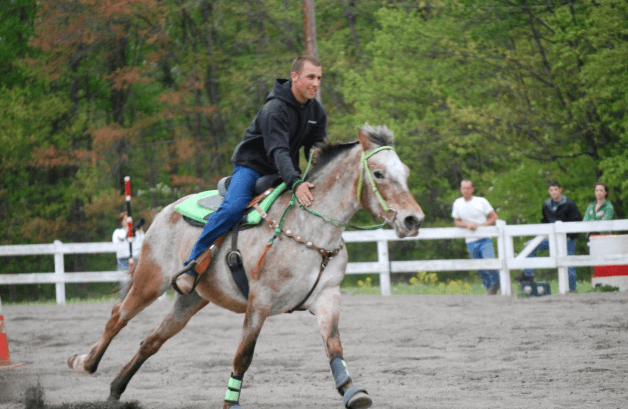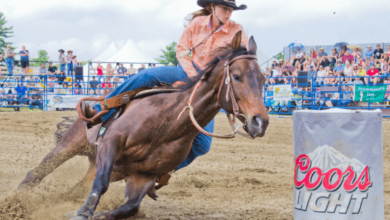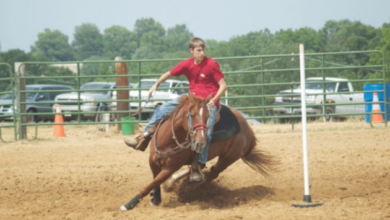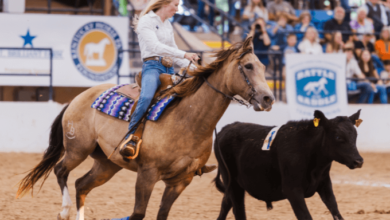What is the ideal breed of horse for pole bending?

Pole bending is a thrilling equestrian sport that demands agility, speed, and precision from both horse and rider. It involves navigating a horse through a series of six poles arranged in a straight line, where the rider must weave in and out at high speed. The combination of sharp turns, quick accelerations, and steady pacing makes this event a true test of a horse’s athletic ability and temperament. While any horse can be trained for pole bending, certain breeds are naturally more suited to excel in this sport due to their specific characteristics, such as agility, quick reflexes, speed, and a strong work ethic.
This article explores the qualities that make a horse ideal for pole bending and identifies the best breeds commonly recognized for excelling in this event.
Qualities Needed for Pole Bending
Before identifying the ideal horse breed for pole bending, it is crucial to understand the qualities that make a horse successful in this sport. Pole bending requires a specific set of physical and mental traits for a horse to perform at its peak.
- Agility: Pole bending is all about making tight, quick turns between the poles. The horse must be nimble and flexible to navigate sharp changes in direction without losing speed or balance. A horse that is naturally agile will have an easier time weaving between the poles, making fast and precise turns.
- Speed and Acceleration: Speed is a key factor in pole bending, especially during the straight runs between the poles. However, the horse must not only be fast but also capable of quick acceleration out of turns. A horse that can swiftly regain its speed after each turn will have a significant advantage.
- Balance and Coordination: Pole bending requires a horse to constantly shift its weight as it moves in and out of the poles. Horses with good balance and coordination can make these transitions smoothly, maintaining their rhythm and minimizing the risk of stumbling or losing their footing.
- Athletic Build: Horses with an athletic build, including strong hindquarters and well-muscled legs, tend to perform better in pole bending. Their muscular build allows them to power through turns and accelerate quickly, while their sturdy frame supports stability and endurance.
- Mental Focus and Trainability: The ideal pole bending horse must be focused and willing to respond quickly to rider cues. Horses that are easily distracted or difficult to control may struggle with the fast pace and intricate movements required for pole bending. A horse with a strong work ethic and a desire to please its rider is invaluable in this sport.
With these qualities in mind, let’s explore the breeds that are often considered ideal for pole bending.
American Quarter Horse
The American Quarter Horse is widely regarded as one of the best breeds for pole bending, and for good reason. Known for their speed, agility, and versatility, Quarter Horses dominate speed-based events like barrel racing and pole bending in rodeos.
- Agility: Quarter Horses are incredibly agile, making them perfect for the tight, quick turns required in pole bending. Their compact, muscular build allows them to maneuver with ease and maintain balance through sharp changes in direction.
- Speed: Bred for short bursts of speed, Quarter Horses excel in events that require fast sprints, such as the straight runs between poles in pole bending. They can quickly accelerate and decelerate as needed, which is crucial for this event.
- Trainability: Known for their calm and cooperative nature, Quarter Horses are highly trainable and responsive to rider cues. Their willingness to learn and follow commands makes them ideal partners in fast-paced, technical events like pole bending.
Because of these traits, Quarter Horses consistently outperform many other breeds in pole bending competitions. Their ability to combine speed and precision sets them apart as one of the top choices for riders aiming for success in the sport.
Appaloosa
The Appaloosa is another breed that excels in pole bending, thanks to its agility and endurance. Originally bred by the Nez Perce tribe for versatility and hardiness, the Appaloosa has developed a reputation for being a reliable and athletic horse.
- Agility and Quickness: Appaloosas are naturally agile, which allows them to navigate the poles with ease. Their strong hindquarters give them the power to make quick turns and changes in direction without losing momentum.
- Endurance: While pole bending is typically a short event, endurance plays a role in the horse’s ability to maintain energy and speed throughout the course. Appaloosas are known for their stamina, which helps them stay sharp and focused even during back-to-back runs.
- Surefootedness: Appaloosas are known for their surefootedness and balance, a trait that comes in handy when navigating through the poles. This balance reduces the risk of stumbling or knocking over poles, a common penalty in competition.
Their unique combination of agility, endurance, and balance makes Appaloosas a strong contender in pole bending, especially for riders looking for a horse that can maintain control and precision in tight spaces.
Paint Horse
The American Paint Horse is another top breed for pole bending, sharing many similarities with the Quarter Horse. Bred for both performance and eye-catching appearance, Paint Horses are known for their strength, agility, and striking coat patterns.
- Agility and Maneuverability: Paint Horses are incredibly agile, making them well-suited to the quick turns and sharp maneuvers required in pole bending. Their muscular build gives them the power to accelerate quickly out of turns, maintaining speed through the course.
- Speed: Like the Quarter Horse, the Paint Horse is known for its burst of speed, which is essential in pole bending. This breed can quickly build up speed during the straight runs and maintain a fast pace while weaving through the poles.
- Trainability and Focus: Paint Horses are intelligent and eager to please, making them highly trainable. Their ability to stay focused on the task at hand is a valuable asset in pole bending, where precision is just as important as speed.
The Paint Horse’s combination of athleticism, intelligence, and agility makes it another excellent breed for riders looking to compete in pole bending events.
Thoroughbred
While Thoroughbreds are often associated with racing, their natural speed and athleticism make them a viable option for pole bending, particularly when crossed with other breeds like Quarter Horses or Paints.
- Speed and Acceleration: Thoroughbreds are known for their incredible speed, which can be a significant advantage in pole bending. While they may not be as compact as Quarter Horses, their long strides allow them to cover ground quickly, especially during the straight runs.
- Athleticism: Thoroughbreds are highly athletic, with strong legs and hindquarters that allow them to power through tight turns. With proper training, they can learn to be more agile and handle the quick changes of direction required in pole bending.
- Endurance and Stamina: While pole bending is a short event, endurance is important, especially in competitions that involve multiple runs. Thoroughbreds’ endurance allows them to maintain their energy and perform consistently across multiple rounds.
Though not as common in pole bending as Quarter Horses or Paints, Thoroughbreds can be highly competitive with the right training, particularly for riders looking for a horse with speed and stamina.
Arabian
Arabians are well-known for their intelligence, stamina, and agility, making them another strong option for pole bending, especially in events that require quick thinking and nimbleness.
- Agility and Flexibility: Arabians are incredibly agile, able to turn quickly and move with grace, which is vital for weaving through poles. Their light, athletic frame allows them to make sharp turns without losing balance or speed.
- Intelligence and Trainability: Arabians are known for their intelligence and quick learning ability. They are responsive to subtle rider cues and can quickly adapt to the fast pace of pole bending, making them easy to train for this event.
- Stamina: Bred for endurance, Arabians can perform well in pole bending events that require multiple runs or quick recovery between rounds. Their natural stamina helps them maintain focus and energy throughout the competition.
Though Arabians may not have the raw power of a Quarter Horse or Paint, their agility and intelligence make them a breed worth considering for pole bending, especially for riders who value finesse over brute strength.
Crossbreeds
In many pole bending competitions, crossbred horses excel because they combine the best traits of different breeds. Crosses between Quarter Horses, Paints, Thoroughbreds, and Arabians can result in horses with exceptional speed, agility, and endurance.
- Quarter Horse-Thoroughbred Cross (Appendix): This popular crossbreed combines the Quarter Horse’s agility and trainability with the Thoroughbred’s speed and stamina. Appendix horses are often seen in pole bending competitions due to their versatility and athleticism.
- Arabian-Quarter Horse Cross: Known as Quarabs, this crossbreed combines the agility and intelligence of the Arabian with the strength and speed of the Quarter Horse. Quarabs can be highly competitive in pole bending, offering a mix of quick reflexes and calm focus.
Crossbreeds can offer riders a unique advantage in pole bending, as they combine multiple desirable traits into one horse.
Conclusion
When it comes to pole bending, the ideal breed of horse is one that combines agility, speed, and responsiveness. The American Quarter Horse stands out as the top choice due to its agility, speed, and natural athleticism. However, other breeds like the Appaloosa, Paint Horse, Thoroughbred, and Arabian also possess the necessary qualities to excel in this event. Additionally, crossbreeds that combine the best traits of multiple breeds can offer a competitive edge in the sport.



